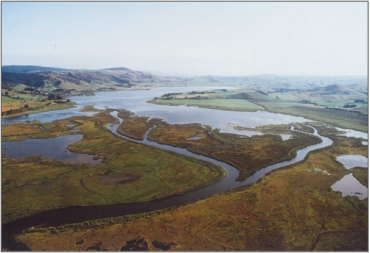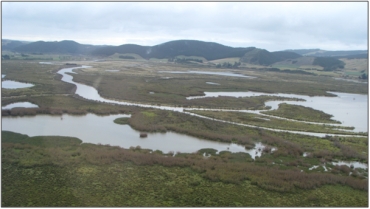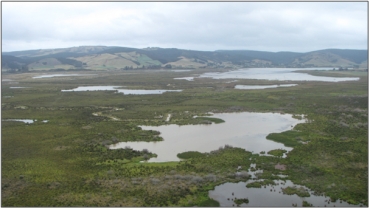Waipori/Waihola Wetland Complex
Description:
The wetland complex consists of two large shallow lakes, Waipori (220 ha) and Waihola (640 ha) and an extensive system of lagoons, ponds, vegetated islands, channels and swamps, situated on the lower Taieri Plain, 30 km south-west of Dunedin. Inflows are from the Waipori River, the Meggatburn, Boundary Creek and several man made drains. The wetlands drain into the Waipori River, then into the Taieri River. 1
Type/Class:
Swamp. 2
Size:
Altitude:
0 - 20 m above sea level.
Approximate location:
West of the intersection of Titri Road and Taieri Plains Highway, Milton.
NZTM (centre point): E1375300 N4900600.
Regional Plan:
Water for Otago.
Schedule 9 Regionally Significant Wetland, no.167, Maps F44 & 45.
Territorial Authority:
Dunedin City Council.
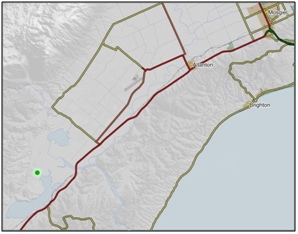
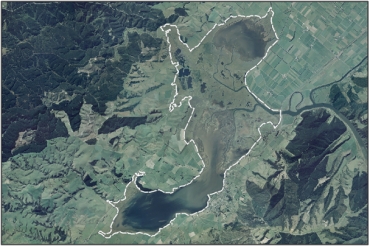
Aerial view of Waipori/Waihola Wetland Complex (March 2006)
Recorded Values:
Value |
Description |
|---|---|
A1 |
Habitat for nationally or internationally rare or threatened species or communities. Habitat for the threatened Australasian Bittern (Botaurus poiciloptilus), the threatened indigenous fish species the giant kokopu (Galaxias argenteus) and the banded kokopu (Galaxias fasciatus). Presence of the threatened plant species swamp nettle (Urtica linearifolia) and tufted hair-grass (Deschampsia caespitosa). 1, 2 , 14 |
A3 |
High diversity of wetland habitat types. A very high diversity of habitat types (see physical description above). Internationally significant as water bird habitat and nationally important fish habitat.53, 88 The best remaining example of a lowland wetland remaining in Otago and one of the largest and most significant remaining in New Zealand. 1 |
A4 |
High degree of wetland naturalness. A high degree of naturalness, notwithstanding drainage activities, and the introduction of exotic species etc. A considerable proportion of the wetland is relatively undisturbed and the plant communities are largely native. A wide variety of native wetland species are present, specifically the native shrubland vegetation, jointed rush communities and back-swamp sedgeland present on the islands of the Waihola River delta. The presence of a sequence of different vegetation types adds to the botanical value. 1, 2, 14 |
A5 |
Scarce in Otago in terms of its ecological or physical character. Wetlands of this type and size are scarce in the region and in New Zealand; this has implications for the conservation of species such as the Australasian bittern and the marsh and spotless crakes, which require large contiguous blocks of swampland in order to maintain viable populations. 1 Less than 15% of swamps remain in Otago. 2 |
A6 |
Highly valued by Kai Tahu for cultural and spiritual beliefs, values and uses including mahika kai and waahi taoka. The wetlands are of historical and cultural importance to Kai Tahu. A site of mahika kai where eels are traditionally gathered. The wetlands are also highly valued as a source of flax. 1 |
A7 |
High diversity of indigenous wetland flora and fauna. A very high diversity of flora and fauna, reflecting the diversity of habitats (above). Fifty five species of birds and twelve species of native fish recorded. Provides habitat for several regionally and locally rare plant and animal species, including the endemic Fernbird (Bowdleria punctata punctata). 1, 14 |
A8 |
Regionally significant wetland habitat for waterfowl. Regionally important habitat for waterfowl, with counts of up to 10,000 ducks and swans. A major breeding and moulting site for Black Swan, Paradise Shelduck, Mallard, Grey Duck, Grey Teal, New Zealand shoveller and New Zealand Scaup. 1 |
A9 |
Significant hydrological values including maintaining water quality or low flows, or reducing flood flows. Performs a valuable hydrological function. Lakes Waipori and Waihola and associated swamps function as a flood ponding area for the lower Taieri Plain. Also play a significant role in maintaining adjacent watertables and downstream flows in summer via the gradual release of ponded water. 1 |
A2 |
No relevant information is currently held by the ORC. |
Other Information:
Other Information:
- A total of 105 ha of the Complex are administered by the Department of Conservation as Wildlife Management Reserve (eg. McClaren’s, Gillander’s Reserves) and marginal strip. See Department of Conservation (1996) for details of management and ownership. In 1995 the Clutha District Council accepted the requirement of the Minister of Conservation for a designation (as a Wildlife Management Area) over most of the wetland. The designation has now lapsed. In November 1996, the Department of Conservation released a Management Statement for the wetland. 1
- Composition of Carex sinclairii, flax and coprosma. 2
- Presence of giant kokopu (Galaxias argenteus) and native grass Deschampsia cespitosa. 2
- Listed in the Clutha District Plan as a Significant Wetland. Described as shrub swamp, rush and sedge swamp, and grass swamp, with habitat and breeding area for a large number of bird species. 37
- Supports a whitebait fishery, a commercial eel fishery, and a recreational perch and brown trout fishery. Both lakes contain giant kokopu (Galaxias argenteus), banded kokopu (Galaxias fasciatus), inanga, long and short finned eels (Anguilla dieffenbachia and Anguilla australis) , bullies, common smelt, lamprey/kanakana, flounder, mullet, perch and brown trout. 53
- Covered by a Statutory Acknowledgement. Was once one of the most significant food baskets in Otago, and was once a settlement of Tukiauau an important tūpuna of Ngāi Tahu Whānui.
- Presence of pukio (Carex secta), wire rush/oioi (Leptocarpus similis), Juncus gregiflorus, New Zealand flax (Phormium tenax), mingimingi (Coprosma propinqua), raupo (Typha orientalis), saltmarsh ribbonwood (Plagianthus divaricatus), small-leaved pohuehue (Muehlenbeckia complexa), and cabbage tree (Cordyline australis). Aquatic plants include blunt pondweed (Potamogeton ochreatus), red pondweed (P. cheesemanii), water milfoil (Myriophyllum triphyllum), and turfland plants Lilaeopsis novae-zelandiae and Glossostigma elatinoides. A remnant of mixed shrub and kanuka (Kunzea ericoides) forest contains species Coprosma crassifolia, and korokio (Corokia cotoneaster).
- Exotic plant species include broom, gorse, willow, and reed sweetgrass. 14
- Common waterfowl include Black Swan (Cygnus atratus), Paradise Shelduck/Putangitangi (Tadorna variegata), Grey Teal/Tete (Anas gracilis), Mallard (A. platyrhynchos), Grey Duck (A. superciliosa), New Zealand shoveller (A. rhynchotis variegata) and New Zealand Scaup/Papango (Aythya novaeseelandiae). 14
- Swamp birds present include Australasian Bittern/Matuku (Botaurus poiciloptilus), Marsh Crake (Porzana pusilla affinis), Pukeko/Swamp Hen (Porphyrio porphyrio melanotus) and South Island Fernbird/Matata (Bowdleria punctata punctata). Two species of shag breed in the wetland - Phalacrocorax spp., White-faced Heron (Egretta novaehollandiae) and Southern Black-backed Gull (Larus dominicanus). Shorebirds include Pied Stilt (Himantopus leucocephalus), South Island Pied Oystercatcher/Torea (Haematopus ostralegus finschi), Spur-winged Plover (Vanellus miles) and Banded Dotterel (Charadrius bicinctus). 14
- Visitors include Brown Teal (Anas aucklandica chlorotis), Banded Rail (Rallus philippensis assimilis), Spotless Crake (Porzana tabuensis plumbea), Cattle Egret (Bubulcus ibis), Little Egret (Egretta garzetta), White Heron (E. alba), and Royal Spoonbill/Kotuku-ngutupapa (Platalea regia). Four species of Terns have been recorded. 14
- The lake beds (860 ha) and 640 ha of swampland are vested in the Otago Regional Council as an endowment of the Taieri River Improvement Act 1920. 35 ha of islands in the northern end of Lake Waihola are also vested in the Council. Small areas are unalienated Crown land and leasehold Crown land (59 ha). Sinclair wetlands is 315.4 ha, is protected by QEII covenant 5/12/005 and has Wildlife Refuge status. 14
References:
1 Otago Regional Council (2004) Regional Plan: Water for Otago. Published by the Otago Regional Council, Dunedin.
2 Ausseil, A.G., Newsome, P., Johnson, P. (2008) Wetland Mapping in the Otago Region. Landcare Research Contract Report prepared for the Otago Regional Council.
14 Cromarty, P. and Scott, D.A. (eds.) (1995) A Directory of Wetlands in New Zealand. Published by the Department of Conservation, Wellington.
37 Clutha District Council (1998) Clutha District Plan. Published by the Clutha District Council, Balclutha.
51 Otago Regional Council – Photo Archive.
53 Davis, S.F. (1987) Wetlands of national importance to fisheries. New Zealand freshwater fisheries report no. 90. Ministry of Agriculture and Fisheries, Christchurch.
